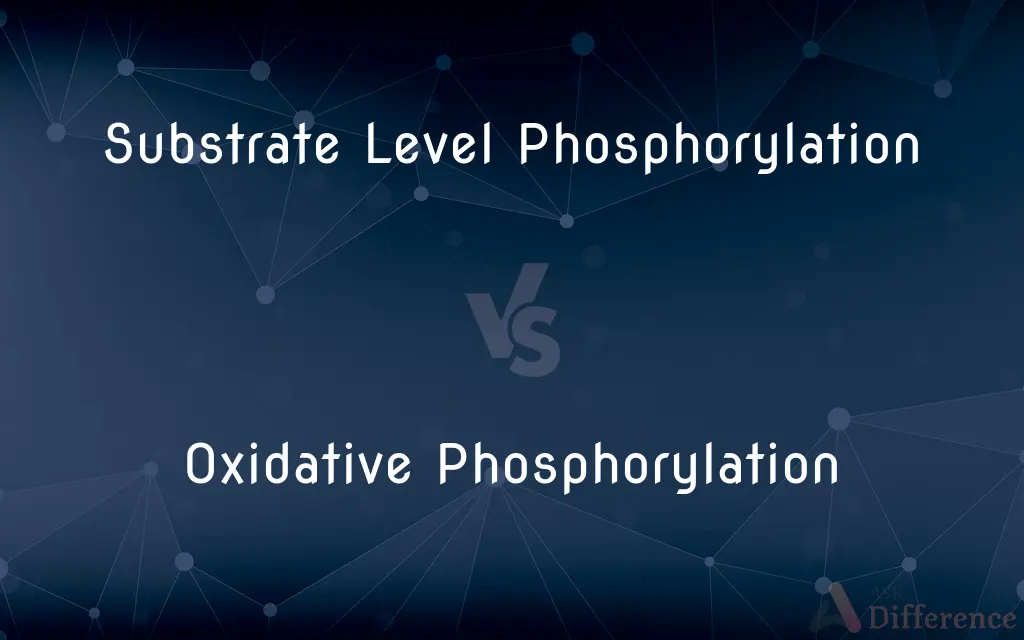Substrate Level Phosphorylation vs. Oxidative Phosphorylation — What's the Difference?
By Tayyaba Rehman — Published on December 11, 2023
Substrate Level Phosphorylation directly transfers phosphate from a substrate to ADP, creating ATP. Oxidative Phosphorylation generates ATP using energy from electron transfer in mitochondria.

Difference Between Substrate Level Phosphorylation and Oxidative Phosphorylation
Table of Contents
ADVERTISEMENT
Key Differences
Substrate Level Phosphorylation and Oxidative Phosphorylation are both mechanisms by which cells produce ATP, the primary energy currency of the cell. Substrate Level Phosphorylation is a process wherein a phosphate group is directly transferred from a high-energy substrate molecule to ADP, resulting in the formation of ATP. This direct transfer means that Substrate Level Phosphorylation doesn't rely on any external energy source other than the energy-rich substrate itself.
On the other hand, Oxidative Phosphorylation is a more complex process that takes place within the mitochondria of eukaryotic cells. It involves a series of electron transfers through a chain of proteins embedded in the mitochondrial inner membrane, known as the electron transport chain. As electrons move through this chain, protons (H+ ions) are pumped across the membrane, creating a proton gradient or a difference in proton concentration.
This proton gradient, also known as the proton motive force, drives the enzyme ATP synthase to synthesize ATP from ADP and inorganic phosphate. Thus, Oxidative Phosphorylation relies on the energy derived from the oxidation of nutrients, particularly glucose and fatty acids, to produce ATP. It's important to note that this process is coupled with cellular respiration and is the primary method by which aerobic organisms produce ATP.
In contrast, Substrate Level Phosphorylation mainly occurs during glycolysis and the citric acid cycle, where a limited amount of ATP is produced directly in the cytosol or mitochondrial matrix. While both processes generate ATP, Oxidative Phosphorylation is responsible for producing the majority of ATP in most aerobic organisms, whereas Substrate Level Phosphorylation provides a quick but limited supply of ATP.
Comparison Chart
Location
Cytosol or mitochondrial matrix
Mitochondrial inner membrane
ADVERTISEMENT
Mechanism
Direct transfer of phosphate
Electron transport and proton gradient
Energy Source
High-energy substrate
Oxidation of nutrients
Amount of ATP produced
Limited
Majority of cellular ATP
Dependency on oxygen
Can occur without oxygen
Requires oxygen as the final electron acceptor
Compare with Definitions
Substrate Level Phosphorylation
Direct synthesis of ATP from ADP using energy from a high-energy substrate.
During glycolysis, Substrate Level Phosphorylation results in the production of ATP.
Oxidative Phosphorylation
Production of ATP using energy from the electron transport chain.
Oxidative Phosphorylation is the main source of ATP in aerobic respiration.
Substrate Level Phosphorylation
Occurs in both cytosol and mitochondrial matrix.
Substrate Level Phosphorylation in the citric acid cycle happens in the mitochondrial matrix.
Oxidative Phosphorylation
Produces the bulk of ATP in aerobic organisms.
For energy efficiency, cells rely heavily on Oxidative Phosphorylation.
Substrate Level Phosphorylation
ATP production not reliant on an external energy gradient.
In Substrate Level Phosphorylation, the energy-rich substrate directly donates a phosphate.
Oxidative Phosphorylation
Dependent on oxygen as the final electron acceptor.
Oxidative Phosphorylation requires oxygen to accept electrons and form water.
Substrate Level Phosphorylation
Integral to glycolysis and the citric acid cycle.
Substrate Level Phosphorylation is an essential step in several metabolic pathways.
Oxidative Phosphorylation
Takes place in the mitochondria of eukaryotic cells.
The mitochondria's inner membrane houses the machinery for Oxidative Phosphorylation.
Substrate Level Phosphorylation
Provides quick energy without the need for oxygen.
Anaerobic conditions can still yield ATP through Substrate Level Phosphorylation.
Oxidative Phosphorylation
Relies on a proton gradient for ATP synthesis.
A proton motive force in Oxidative Phosphorylation drives ATP synthase activity.
Common Curiosities
What's the primary energy source for Substrate Level Phosphorylation?
The primary energy source is the high-energy substrate molecule.
Which process produces more ATP overall?
Oxidative Phosphorylation produces the majority of ATP in aerobic cells.
Where does Oxidative Phosphorylation mainly occur?
Oxidative Phosphorylation occurs in the inner membrane of the mitochondria.
What's the role of oxygen in Oxidative Phosphorylation?
Oxygen acts as the final electron acceptor, forming water.
Can Substrate Level Phosphorylation function without oxygen?
Yes, it can function anaerobically, without the need for oxygen.
When does Substrate Level Phosphorylation happen during metabolism?
It occurs during glycolysis and the citric acid cycle.
Why is Oxidative Phosphorylation considered more efficient?
It harnesses more energy from nutrient molecules, producing more ATP.
What creates the proton gradient in Oxidative Phosphorylation?
The electron transport chain pumps protons across the mitochondrial membrane.
Does Substrate Level Phosphorylation need an enzyme?
Yes, specific enzymes facilitate the direct phosphate transfer.
Is Substrate Level Phosphorylation exclusive to eukaryotic cells?
No, it also occurs in prokaryotic cells during glycolysis.
How does ATP synthase work in Oxidative Phosphorylation?
It utilizes the proton gradient to convert ADP and inorganic phosphate into ATP.
How is Oxidative Phosphorylation affected in low oxygen conditions?
Without adequate oxygen, the process slows or halts, reducing ATP production.
Can Substrate Level Phosphorylation support long-term energy needs?
No, it provides quick energy but not in large quantities.
What's the end product of Oxidative Phosphorylation?
Water is formed when oxygen accepts electrons.
How does cell type impact Substrate Level Phosphorylation?
Muscle cells might rely more on it during short, intense activity.
Share Your Discovery

Previous Comparison
Absolute Advantage vs. Comparative Advantage
Next Comparison
Beta Particle vs. ElectronAuthor Spotlight
Written by
Tayyaba RehmanTayyaba Rehman is a distinguished writer, currently serving as a primary contributor to askdifference.com. As a researcher in semantics and etymology, Tayyaba's passion for the complexity of languages and their distinctions has found a perfect home on the platform. Tayyaba delves into the intricacies of language, distinguishing between commonly confused words and phrases, thereby providing clarity for readers worldwide.












































